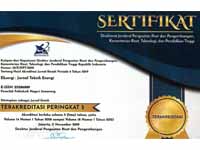Linearity of Soil Moisture in Residential Plants Using Soil moisture sensor YL-69
DOI:
https://doi.org/10.32497/eksergi.v20i01.5412Keywords:
Soil moisture sensor YL-69, NodeMCUESP8266, LinearityAbstract
Planting media for plants is very important because various kinds of ornamental plants used in housing can grow well according to the needs of their respective conditions. Soil moisture is generally defined as the water contained on the unsaturated soil surface of the Earth. Soil moisture has an influence on the level of moisture needed by plants. The use of soil moisture sensor YL-69s is very popular, especially in the last 2 - 3 decades, where these sensors can review soil moisture and soil conditions in percentage form. However, how can the value of the soil moisture sensor YL-69 itself represent actual conditions? For this reason, a design was carried out with the aim of seeing the linearity value of the sensor. In the overall test the average error value produced has reached less than 3%. In this study, "Nor" conditioning needs to be developed again to further specify whether the plant's moisture needs require a separate percentage to reduce the margin gap that appears at the transition between dry and wet conditions. In this study, using the YL-69 soil moisture sensor produced an error value up to 6.16%, especially in the "Nor" condition with a conditioning difference of 13%.References
N. D. Rahayu, B. Sasmito, and N. Bashit, "Analisis pengaruh fenomena Indian Ocean Dipole (IOD) terhadap curah hujan di pulau Jawa," Jurnal Geodesi Undip, vol. 7, no. 1, pp. 57-67, 2018.
A. Savelli et al., "Climate-Smart Agriculture in Indonesia," CSA Country Profiles for Asia Series, 2021.
T. Nuraya, "Pelatihan Pembuatan Media Tanam Untuk Tanaman Hias dan Tanaman Toga," Prosiding Penelitian Pendidikan dan Pengabdian 2021, vol. 1, no. 1, pp. 677-682, 2021.
T. Batool et al., "Plant growth promoting rhizobacteria alleviates drought stress in potato in response to suppressive oxidative stress and antioxidant enzymes activities," Scientific Reports, vol. 10, no. 1, p. 16975, 2020.
H. Hamidah, "BUDIDAYA TANAMAN HIAS SKALA RUMAH TANGGA," Jurnal Pengabdian Kreativitas Pendidikan Mahakam (JPKPM), vol. 3, no. 2, pp. 140-144, 2023.
C. S. Rocha, D. C. Rocha, L. Y. Kochi, D. N. M. Carneiro, M. V. Dos Reis, and M. P. Gomes, "Phytoremediation by ornamental plants: a beautiful and ecological alternative," Environmental Science and Pollution Research, pp. 1-19, 2022.
Y. Deng et al., "Variation trend of global soil moisture and its cause analysis," Ecological Indicators, vol. 110, p. 105939, 2020.
W. Dorigo et al., "The International Soil Moisture Network: serving Earth system science for over a decade," Hydrology and earth system sciences, vol. 25, no. 11, pp. 5749-5804, 2021.
Y. Liu and Y. Yang, "Advances in the Quality of Global Soil Moisture Products: A Review," Remote Sensing, vol. 14, no. 15, p. 3741, 2022.
D. L. Hoover, A. A. Pfennigwerth, and M. C. Duniway, "Drought resistance and resilience: The role of soil moisture”“plant interactions and legacies in a dryland ecosystem," Journal of Ecology, vol. 109, no. 9, pp. 3280-3294, 2021.
F. Zhao, G. Wang, S. Li, D. F. T. Hagan, and W. Ullah, "The combined effects of VPD and soil moisture on historical maize yield and prediction in China," Frontiers in Environmental Science, vol. 11, p. 1117184, 2023.
L. Yu et al., "Review of research progress on soil moisture sensor technology," 2021.
H. Husdi, "monitoring kelembaban tanah pertanian menggunakan soil moisture sensor fc-28 dan arduino uno," ILKOM Jurnal Ilmiah, vol. 10, no. 2, pp. 237-243, 2018.
D. B. Anggoro, A. P. Sari, V. Sharaswati, O. P. Sari, and A. Muamar, "Penyiram Tanaman Otomatis Menggunakan Soil Moisture Berbasis Arduino Uno," in SEMINAR NASIONAL TEKNOLOGI INFORMASI & KOMUNIKASI, 2021, vol. 1, no. 1, pp. 183-190.
D. D. Yoridho, S. H. Adi, and R. Siskandar, "Rancang Bangun Sistem Navigasi Kekeringan dan Meluapnya Air pada Lahan Berbasis web di BALITKLIMAT," Jurnal Sains Indonesia, vol. 1, no. 3, pp. 144-151, 2020.
M. Jefri, "Implementasi IoT Penyiraman Tanaman Sawi Menggunakan esp2866 dan Construct 2," Jurnal Portal Data, vol. 2, no. 4, 2022.
Downloads
Published
Issue
Section
License
Authors who publish with this journal agree to the following terms:Authors retain copyright and grant the journal right of first publication with the work simultaneously licensed under a Creative Commons Attribution License that allows others to share the work with an acknowledgement of the work's authorship and initial publication in this journal.
Authors are able to enter into separate, additional contractual arrangements for the non-exclusive distribution of the journal's published version of the work (e.g., post it to an institutional repository or publish it in a book), with an acknowledgement of its initial publication in this journal.
Authors are permitted and encouraged to post their work online (e.g., in institutional repositories or on their website) prior to and during the submission process, as it can lead to productive exchanges, as well as earlier and greater citation of published work (See The Effect of Open Access).






